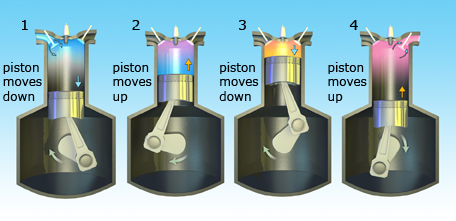Lesson 2: Equations and Graphs of Trigonometric Functions
Focus

Hemera/Thinkstock
A four-stroke engine goes through a four-step cycle. 1. Fuel and air are added
to the cylinder as the piston moves down. 2. The piston moves up again,
compressing the fuel and air mixture. 3. The fuel and air are ignited, producing
hot gas and forcing the piston down. 4. As the piston rises, the spent fuel and
air are expelled.
Many internal combustion engines in vehicles follow the “four-stroke” process (shown in the diagram) to produce rotational motion. Think about what happens to a piston over time. How predictable is the motion? What information would you need to determine the position of a piston over time?
Lesson Outcomes
At the end of this lesson you will be able to use trigonometric equations and graphs to model and solve problems.
Lesson Questions
In this lesson you will investigate the following question:
- How can a problem be solved using a trigonometric model?
Assessment
Your assessment may be based on a combination of the following tasks:
- completion of the Lesson 2 Assignment (Download the Lesson 2 Assignment and save it in your course folder now.)
- course folder submissions from Try This and Share activities
- additions to Glossary Terms
- work under Project Connection